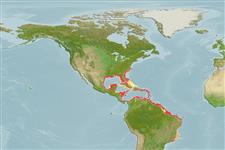>
Eupercaria/misc (Various families in series Eupercaria) >
Gerreidae (Mojarras)
Etymology: Diapterus: Greek, di = two + Greek, pteron = wing, fin (Ref. 45335).
Environment: milieu / climate zone / distribuzione batimetrica / distribution range
Ecologia
marino; salmastro demersale. Tropical; 37°N - 24°S, 98°W - 33°W
Western Atlantic: USA (Florida and North Carolina) and Greater Antilles to São Paulo, Brazil (Ref. 57756).
Length at first maturity / Size / Peso / Age
Maturità: Lm 12.0 range ? - ? cm
Max length : 42.8 cm TL maschio/sesso non determinato; (Ref. 122735); common length : 20.0 cm TL maschio/sesso non determinato; (Ref. 5217); peso massimo pubblicato: 1.0 kg (Ref. 122735)
Inhabits shallow coastal waters, especially in mangrove-lined creeks and lagoons, but also found on vegetated sand grounds in typical marine areas. Young more widespread than adults. Feeds on bottom-dwelling invertebrates. Consumed fresh.
Cervigón, F., R. Cipriani, W. Fischer, L. Garibaldi, M. Hendrickx, A.J. Lemus, R. Márquez, J.M. Poutiers, G. Robaina and B. Rodriguez, 1992. Fichas FAO de identificación de especies para los fines de la pesca. Guía de campo de las especies comerciales marinas y de aquas salobres de la costa septentrional de Sur América. FAO, Rome. 513 p. Preparado con el financiamento de la Comisión de Comunidades Europeas y de NORAD. (Ref. 5217)
IUCN Red List Status (Ref. 130435: Version 2025-1)
Threat to humans
Harmless
Human uses
Pesca: scarso interesse commerciale
Strumenti
Special reports
Download XML
Fonti Internet
Estimates based on models
Preferred temperature (Fonte Biblio.
123201): 23.8 - 28, mean 26.7 °C (based on 342 cells).
Phylogenetic diversity index (Fonte Biblio.
82804): PD
50 = 0.5625 [Uniqueness, from 0.5 = low to 2.0 = high].
Bayesian length-weight: a=0.01122 (0.00939 - 0.01341), b=3.08 (3.03 - 3.13), in cm total length, based on LWR estimates for this species (Ref.
93245).
Trophic level (Fonte Biblio.
69278): 2.4 ±0.9 se; based on diet studies.
Resilienza (Fonte Biblio.
120179): Medio, tempo minimo di raddoppiamento della popolazione 1.4 - 4.4 anni (Preliminary K or Fecundity.).
Fishing Vulnerability (Ref.
59153): Low to moderate vulnerability (33 of 100).
🛈
Nutrients (Ref.
124155): Calcium = 169 [98, 340] mg/100g; Iron = 1.17 [0.59, 2.11] mg/100g; Protein = 18.4 [16.5, 20.2] %; Omega3 = 0.225 [0.120, 0.408] g/100g; Selenium = 50.4 [28.0, 99.6] μg/100g; VitaminA = 14.8 [4.4, 38.1] μg/100g; Zinc = 1.75 [1.19, 2.53] mg/100g (wet weight);
